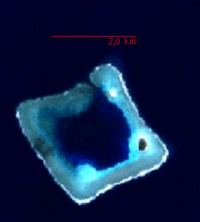Rose Atoll
| Rose Atoll | |
|---|---|
| Atoll | |
 | |
 | |
| Coordinates: 14°32′48″S 168°09′07″W / 14.54667°S 168.15194°WCoordinates: 14°32′48″S 168°09′07″W / 14.54667°S 168.15194°W | |
| Territory | American Samoa |
| Area | |
| • Land | 0.083 sq mi (0.214 km2) |
| Population | |
| • Total | 0 |

Rose Atoll, sometimes called Rose Island or Motu O Manu by people of the nearby Manu'a Islands, is an oceanic atoll within the U.S. territory of American Samoa. It is an uninhabited wildlife refuge. It is the southernmost point belonging to the United States. The land area is 0.214 km² (52.8 acres). The total area of the atoll, including lagoon and reef flat amounts to 5 km². Just west of the northernmost point is a channel into the lagoon, about 40 m wide. There are two islets on the northwestern rim of the reef, larger Rose Island in the east (3.5 m high) and the non-vegetated Sand Island in the north (1.5 m high).
The first documented sighting by a Westerner was by Louis de Freycinet in 1819. He named it after his wife Rose. While the second woman to circumnavigate the globe, Rose de Freycinet was the first to tell her tale.[1] In his official report Louis deFreycinet records that 'I named Rose Island, from the name of someone who is extremely dear to me'.[2] Soon afterwards, in 1824, it was seen by the expedition under Otto von Kotzebue, who named it Kordinkov after his First Lieutenant.
The Rose Atoll Marine National Monument that lies on the two outstanding islands of the Atoll is managed cooperatively between the U.S. Fish and Wildlife Service and the government of American Samoa.
Fish and wildlife
Rose Atoll contains the largest populations of giant clams, nesting seabirds and rare reef fish in all of American Samoa. The fish population is unique from the rest of the region due to a high concentration of carnivorous fish and low concentration of herbivorous fish. Almost 270 different species of fish have been recorded in the last 15 years. Tuna, mahi-mahi, billfish, barracuda and sharks reside outside the lagoon. In deeper waters, tunicate and stalked crinoid have been spotted by scuba expeditions. Sea mammals such as the endangered humpback whale and the Stenella genus of dolphin also use the waters.[3]
The atoll is a critical nesting habitat for the threatened green turtle and the endangered hawksbill turtle. The turtles migrate between American Samoa and other Pacific Island nations. Their nesting season is between the months of August and February.
Approximately 97% of American Samoa's seabird population resides on Rose Atoll. Each of the 12 bird species is federally protected. Red-footed boobies and greater and lesser frigate birds nest in the buka trees. Black noddies and white terns nest in the middle and lower branches. The root system is used by the reef herons and red-tailed tropic birds. Other birds can be found in the Pisonia forest, the only one left in Samoa.[4]
References
- ↑ http://202.14.152.30/collections/maritime/march/treasures/uranie/rose_etc.html
- ↑ Rivière, M.S., 1996, A Woman of Courage: The journal of Rose de Freycinet on her voyage around the world 1817-1820. National Library of Australia. Canberra: xxi
- ↑ "US Fish & Wildlife Rose Atoll Marine National Monument". August 25, 2009. Retrieved August 25, 2009.
- ↑ "US Fish & Wildlife Service Rose Atoll Wildlife and Habitat". August 25, 2009. Retrieved August 25, 2009.
- American Samoa, its districts and unorganized islands, United States Census Bureau
- A Summary of Information on Rose Atoll (Atoll Research Bulletin #29)
| ||||||||||||||||||||